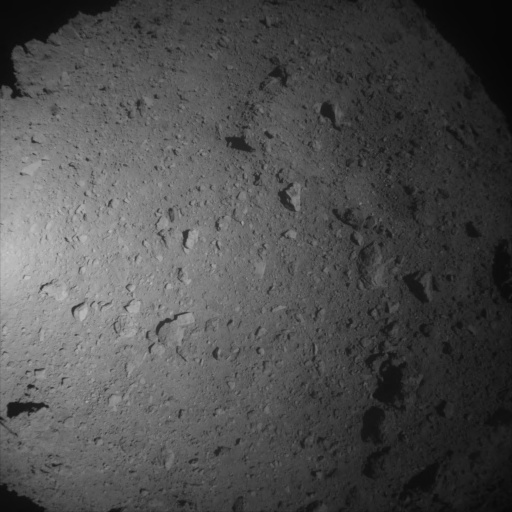Boop! Japanese Spacecraft Grabs Second Sample from Asteroid Ryugu
It's rare for a spacecraft to "boop" an asteroid twice.

It looks like Japan's Hayabusa2 spacecraft has snagged its second souvenir from asteroid Ryugu, marking one of the last major milestones of the probe's visit.
Today's (July 10) maneuver was a calculated risk, as mission staff sought to weigh the scientific value of a subsurface sample with the possibility that failure would jeopardize the sample that the team believes is on board the spacecraft. Now, Hayabusa2 has just one more rover to deploy on the space rock before it departs at the end of the year.
Related: Pow! Japan's Hayabusa2 Bombs Asteroid Ryugu to Make a Crater (Photo)
The maneuver stretched on for hours as the Japan Aerospace Exploration Agency's (JAXA) Hayabusa2 slowly lowered itself to the surface. At 100 feet (30 meters) above the surface, the spacecraft spotted the bright, white target marker it had dropped during a preparatory procedure.
That marker is 65 feet (20 m) north of the site where, in April, the spacecraft deployed a copper bomb to create an artificial crater in order to look below the asteroid's surface. (JAXA had decided that sampling sites within the crater itself were too rocky and would risk the spacecraft's safety.)
Finally, at about 9:15 p.m. EDT (0115 GMT on July 11), Hayabusa2 touched down, fired a tantalum bullet into the space rock and — if all went according to plan — collected a bit of the resulting debris. That debris should be extra-special — not just any space rock, but pristine material dug out from below the surface of the space rock by the formation of the crater.
Because Ryugu does not have an atmosphere or magnetic field, the asteroid's surface is exposed to all the hazards of space. Cosmic rays and charged particles of solar wind streaming off the sun pummel Ryugu and its companions, altering the rock at the exterior of these bodies.
Get the Space.com Newsletter
Breaking space news, the latest updates on rocket launches, skywatching events and more!
But underneath these shells, asteroids contain the rubble left over from the birth of the planets. That's why scientists hope that today's procedure in particular will help them understand how the solar system formed: by allowing them to not just analyze the crater that Hayabusa2 created on the surface but also get that rock into labs here on Earth.
[PPTD] July 11 at 10:51 JST: Gate 5 check. The state of the spacecraft is normal and the touchdown sequence was performed as scheduled. Project Manager Tsuda has declared that the 2nd touchdown was a success!July 11, 2019
The Hayabusa2 spacecraft was designed with three compartments for sample storage. Mission staff believed two of those compartments were already holding pieces of Ryugu; now they hope the third one does as well.
But until the spacecraft makes its way back to Earth and scientists can get inside that sample storage system, they aren't sure what's in there. Once the samples arrive, the team will first weed out anything from the spacecraft's operations; the metals of the bomb and bullets used during the mission were chosen because they do not exist on asteroids and so will be easy to identify and discard.
Then, it's all about the asteroid science, whatever that turns out to be. JAXA ran into trouble during the sampling portion of Hayabusa2's predecessor mission and ended up with minuscule grains of an asteroid called Itokawa in 2010. Yet scientists have still made discoveries based on that dust. For example, they found that there is water on the space rock and that Itokawa seems to be built from rubble formed during a large collision. If Hayabusa2 has grabbed larger hunks of asteroid, that's more material for more science.
Of course, all that will have to wait until the spacecraft makes its journey back to Earth. It has one more task to accomplish first: deploying a small rover, called MINERVA-II2, later this summer. Then, in November or December, Hayabusa2 will head home, delivering its bounty toward the end of next year.
- Watch Japan's Hayabusa2 Grab a Piece of an Asteroid in This Incredible Video!
- Shadow Selfie! Japanese Asteroid Probe Snaps Amazing Post-Landing Pic
- Japan's Hopping Rovers Capture Amazing Views of Asteroid Ryugu (Video)
Email Meghan Bartels at mbartels@space.com or follow her @meghanbartels. Follow us on Twitter @Spacedotcom and on Facebook.
Join our Space Forums to keep talking space on the latest missions, night sky and more! And if you have a news tip, correction or comment, let us know at: community@space.com.

Meghan is a senior writer at Space.com and has more than five years' experience as a science journalist based in New York City. She joined Space.com in July 2018, with previous writing published in outlets including Newsweek and Audubon. Meghan earned an MA in science journalism from New York University and a BA in classics from Georgetown University, and in her free time she enjoys reading and visiting museums. Follow her on Twitter at @meghanbartels.









